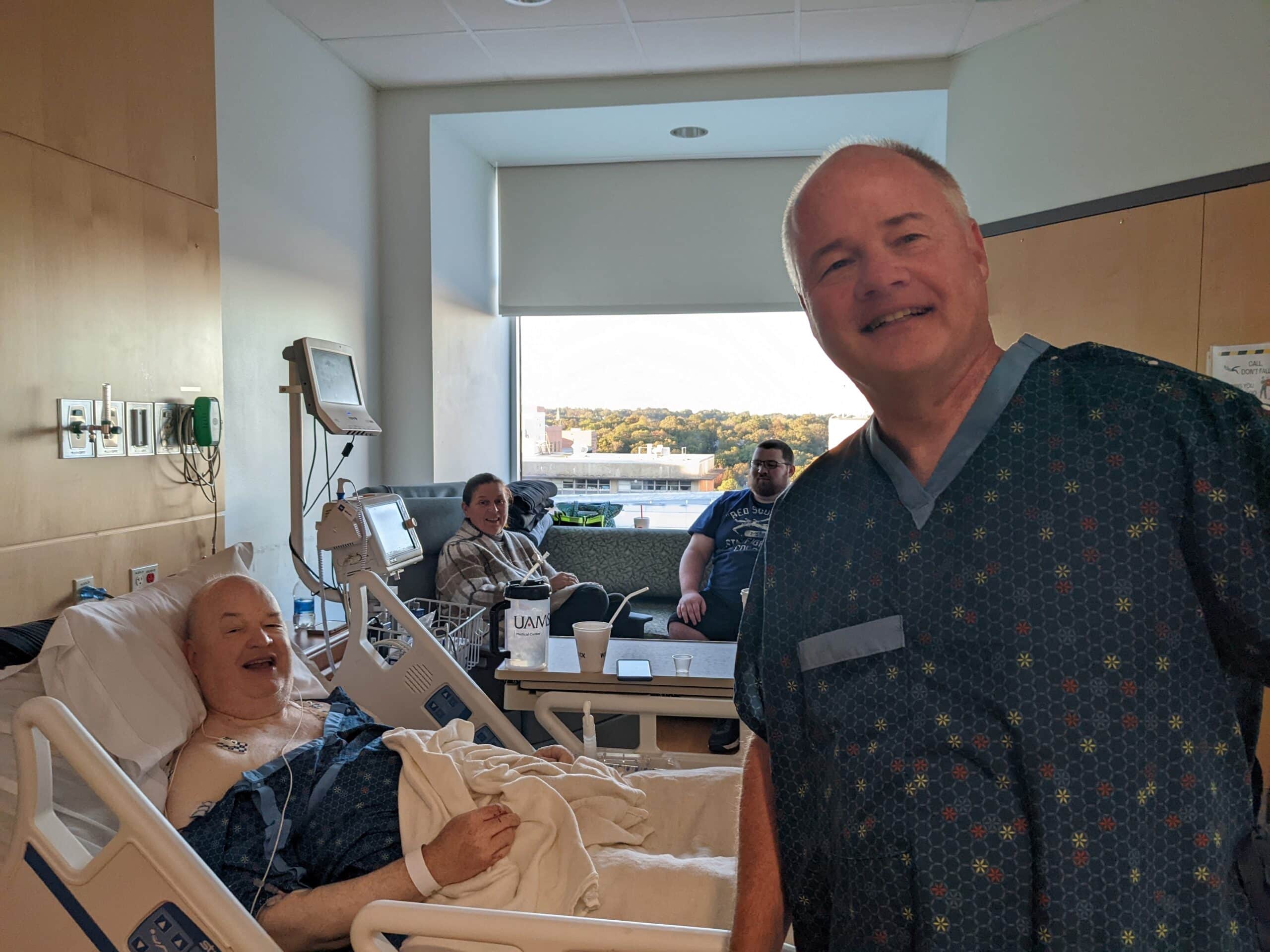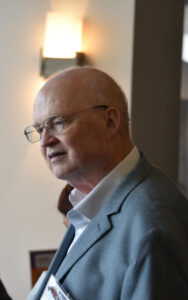Brotherly Love — UAMS’ Chief Nephrologist Receives Kidney from Younger Sibling
| John Arthur, chief kidney doctor at the University of Arkansas Medical Sciences (UAMS), understands the benefits of a living kidney donation more than most people would expect.
As the director of the Division of Nephrology in the UAMS Department of Internal Medicine since 2015, he has long been aware that about 100,000 patients across the country are awaiting kidney transplants on any given day. He knows there are not enough kidneys to go around, which means that some die before a kidney becomes available.
But six months ago, Arthur came to understand the situation from a personal perspective. He experienced firsthand the fear of needing a life-saving organ.
Arthur’s need for a new kidney stemmed from a leukemia diagnosis in 2007 that required him to undergo chemotherapy and receive a stem-cell transplant from one of his brothers. He lost half his kidney function as a result, and over the next 16 years, his remaining kidney function declined gradually, to the point that in 2023, he needed a new one.
Arthur was fortunate, in that he had another brother, Steve Arthur, who had a compatible immune system and a healthy kidney to spare, as well as the willingness to donate the organ, in the name of brotherly love.
Still, it wasn’t easy to ask another person, even a brother, to give up a major organ.
Urgent Need for Kidneys
Now, with Donate Life Month underway and the six-month anniversary of the transplant approaching at month’s end, the brothers want potential donors to understand both the urgent need for living kidney donations and the low risk of future repercussions.
According to the National Kidney Foundation, a living donor transplant has several added benefits for the recipient over a deceased donor transplant. Yet the scarcity of living kidney donations means that most donations come from deceased donors.
Even if the deceased donor was exceptionally healthy, the time that lapses before the kidneys can be retrieved and transfused with blood reduces their viability, often requiring the recipient to be on dialysis after a transplant, while the new kidney is recovering.
Meanwhile, the quality of life for patients on the waiting list has already been compromised, even with dialysis, which Arthur said isn’t as efficient as a functioning kidney in filtering waste and fluids from the body. And in many cases, the recipient is on the list for a long time, progressively becoming more ill.
“If you’re on the deceased donor list, you’re probably going to wait two years, and that’s if you’re here in Arkansas, where we have the second-shortest time in the country out of about 150 transplant centers,” Arthur said. “In other places in the country, it might be five years. It can really take a long time.”
Dialysis also isn’t a long-term solution, he said. “The mortality on dialysis is 25% after one year of dialysis and 50% after five years of dialysis, so your chance of dying from end-stage kidney disease is actually much worse than for most cancers.”
“It would be a tremendous lifesaver if we can get people to donate living kidneys,” Arthur said.
The Kidney Foundation says living kidney donations shorten a patient’s time on dialysis, lessen the recipient’s risk of rejection when the donor is a family member, allow the surgery to be planned for when both patient and donor are at their healthiest and have a better record of functioning immediately after transplant.
On average, a kidney from a living donor lasts about 15 to 20 years, compared to seven to 10 years for one from a deceased donor.
“Through the generosity of living kidney donation, we have the power to transform not just lives, but entire futures,” said Sushma Bhusal, M.D., medical director for kidney transplantation at UAMS. “Sharing a kidney while you’re alive means sharing life itself. It’s a powerful act of kindness that can change someone’s whole world for the better. It’s not just a gift of life; it’s a chance to be someone’s hero, to give them more time with their loved ones, more laughter, more joy. I urge everyone to consider donating.”
Arthur was fortunate to receive a kidney from his brother before his kidneys deteriorated to the point that he needed dialysis. Called a preemptive transplant, this can substantially improve a patient’s quality of life after the transplant.
“I can already vouch for that,” Arthur said in late January. “After just three months since my transplant, my quality of life is way better than it was before my transplant.”
Donor Criteria
He said many people don’t realize that donors don’t need to be related to a recipient or necessarily have the same blood type.
They must be at least 18 years old — or 21 in some states — and generally younger than 60. Some medical conditions can prevent a person from being a donor, but each transplant center has slightly different requirements.
Donors undergo careful preoperative testing and evaluation to ensure they are healthy enough for surgery, and the risk of death from surgery for living kidney donors is very low. In fact, the National Kidney Foundation reports that in one study of more than 80,000 living kidney donors, death from surgery was 3.1 per 10,000 donors — a rate that hasn’t changed in 15 years.
For living donors, the Kidney Foundation says that any loss in kidney function is minimal, and the donor’s life span is usually unaffected.
Meanwhile, the donor’s medical expenses, including evaluation and surgery, are covered by the recipient’s health insurance, and there are programs that help cover travel and lodging costs for the donor.
Living donors can make a directed donation, which names a specific recipient, or a “Good Samaritan” donation that is available for anyone who is waiting and matches the donor’s medical profile.
In most cases, the surgery is a minimally invasive laparoscopic procedure.
‘No Harm in Asking’
John Arthur, 64, said his worsening kidney function was gradual, “so it was kind-of hard to tell that it was happening. But since I’ve had the transplant, I feel a lot better than I did. I notice it. My wife notices it. I just feel better, and I have more energy.”
But before he got the kidney, he had to ask for it.
“People have a hard time asking,” he acknowledged. “They think, ‘Well, I can’t ask my brother,’ or, “I can’t ask my wife,’ because it’s just too much.
“Even for me, as the chief of nephrology and having done a fair amount of work as a transplant nephrologist, it was awkward to ask,” he said. “But for someone who is not a kidney doctor, it’s got to be a lot harder.”
Asked if he had any advice for asking, he said, “I would say just do it. You have to respect that the person might say no for whatever reason, and they definitely have the right to do that, and you really shouldn’t question that. But there’s no harm in asking.”
The availability of living kidney donors in Arkansas is quite low compared to other parts of the country, Arthur said, particularly among Black people, who are more likely than their white counterparts to develop kidney disease and require dialysis. This is despite the UAMS kidney and liver transplant programs being one of the larger centers in the United States, in terms of the numbers of transplants done, and consistently receiving some of the highest national rankings from the Scientific Registry of Transplant Recipients (SRTR).
“A lot of that unwillingness to ask relatives or other people to donate is social and cultural, and there also may be a hesitancy for donors to come forward and say that they’re willing to donate,” John Arthur said.
Arthur’s primary surgeon was Martha Michelle Estrada, M.D., a board-certified transplant/hepatobiliary surgeon at UAMS, while Steve Arthur’s was Raj Patel, M.D., a fellowship-trained UAMS transplant surgeon who specializes in the kidney, liver and pancreas.
“They did a work-up on me over the course of maybe two months,” Steve Arthur confirmed. “They checked everything under the sun, as far as I could see. They ensured that I was healthy and that giving a kidney was not going to be an issue for me.”
He said that once the tests were done, he returned to UAMS from his home in St. Louis just one day before the Oct. 31, 2023, surgery. The surgery lasted several hours, and he was discharged the following day, though the brothers recuperated together at John Arthur’s Little Rock home for about a week, with the help of their wives.
Steve Arthur, who turned 60 three months after the transplant, said he was back to playing volleyball at full force just six weeks after the surgery, and “I felt like I was 100% after three months.”
He said he has no regrets.
“I think part of what drove me to say yes when he asked me is that I love my brother,” he said. “I could see the benefit that it would be to him, and the need was there. But my faith drove me as well. I’m a Christian, and for me to say the sacrifice is too much is not something I could do.”
For more information about becoming a living kidney donor, visit uamshealth.com/organ-transplant-information/living-donor/.

